Health Informatics: Impact of Technology in Healthcare Report
VerifiedAdded on 2022/10/17
|6
|1250
|489
Report
AI Summary
This report provides an overview of health informatics, focusing on the critical role of technology in improving healthcare processes. It examines the importance of data capturing, recording, analysis, and sharing within healthcare organizations, emphasizing the sensitive nature of patient data. The report explores the application of health information technology systems, commonly known as health informatics, and their impact on hospitals. It highlights the use of databases like HCUP and WISQARS for data analysis and research, and how these tools support healthcare decision-making. The report also details the utilization of various health informatics tools, applications, and technologies such as EHRs and real-time alerting, and their impact on patient care. It concludes by discussing the practical advantages of employing technology in health information, including cost reduction, improved quality of care, and enhanced patient experiences.
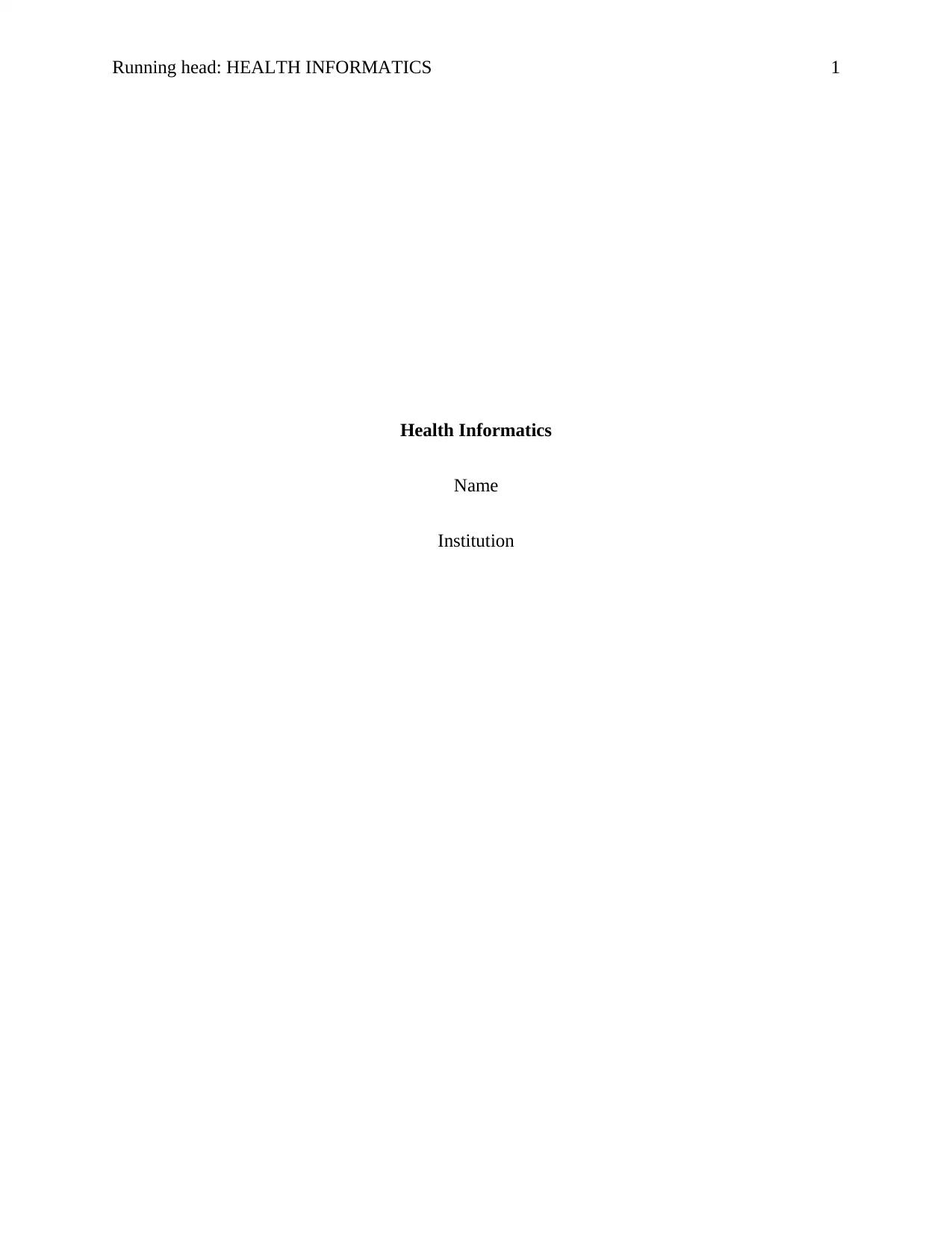
Running head: HEALTH INFORMATICS 1
Health Informatics
Name
Institution
Health Informatics
Name
Institution
Paraphrase This Document
Need a fresh take? Get an instant paraphrase of this document with our AI Paraphraser
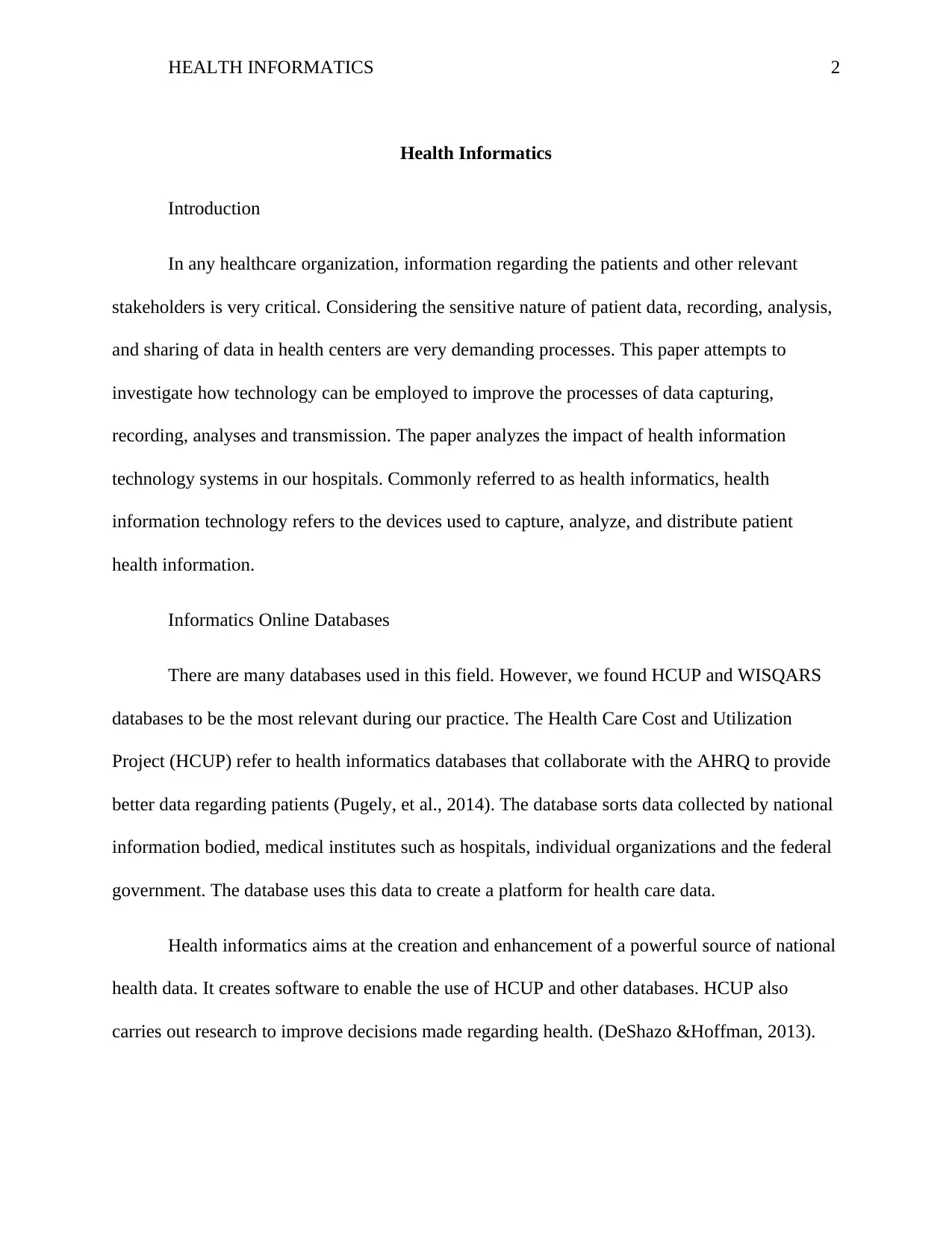
HEALTH INFORMATICS 2
Health Informatics
Introduction
In any healthcare organization, information regarding the patients and other relevant
stakeholders is very critical. Considering the sensitive nature of patient data, recording, analysis,
and sharing of data in health centers are very demanding processes. This paper attempts to
investigate how technology can be employed to improve the processes of data capturing,
recording, analyses and transmission. The paper analyzes the impact of health information
technology systems in our hospitals. Commonly referred to as health informatics, health
information technology refers to the devices used to capture, analyze, and distribute patient
health information.
Informatics Online Databases
There are many databases used in this field. However, we found HCUP and WISQARS
databases to be the most relevant during our practice. The Health Care Cost and Utilization
Project (HCUP) refer to health informatics databases that collaborate with the AHRQ to provide
better data regarding patients (Pugely, et al., 2014). The database sorts data collected by national
information bodied, medical institutes such as hospitals, individual organizations and the federal
government. The database uses this data to create a platform for health care data.
Health informatics aims at the creation and enhancement of a powerful source of national
health data. It creates software to enable the use of HCUP and other databases. HCUP also
carries out research to improve decisions made regarding health. (DeShazo &Hoffman, 2013).
Health Informatics
Introduction
In any healthcare organization, information regarding the patients and other relevant
stakeholders is very critical. Considering the sensitive nature of patient data, recording, analysis,
and sharing of data in health centers are very demanding processes. This paper attempts to
investigate how technology can be employed to improve the processes of data capturing,
recording, analyses and transmission. The paper analyzes the impact of health information
technology systems in our hospitals. Commonly referred to as health informatics, health
information technology refers to the devices used to capture, analyze, and distribute patient
health information.
Informatics Online Databases
There are many databases used in this field. However, we found HCUP and WISQARS
databases to be the most relevant during our practice. The Health Care Cost and Utilization
Project (HCUP) refer to health informatics databases that collaborate with the AHRQ to provide
better data regarding patients (Pugely, et al., 2014). The database sorts data collected by national
information bodied, medical institutes such as hospitals, individual organizations and the federal
government. The database uses this data to create a platform for health care data.
Health informatics aims at the creation and enhancement of a powerful source of national
health data. It creates software to enable the use of HCUP and other databases. HCUP also
carries out research to improve decisions made regarding health. (DeShazo &Hoffman, 2013).
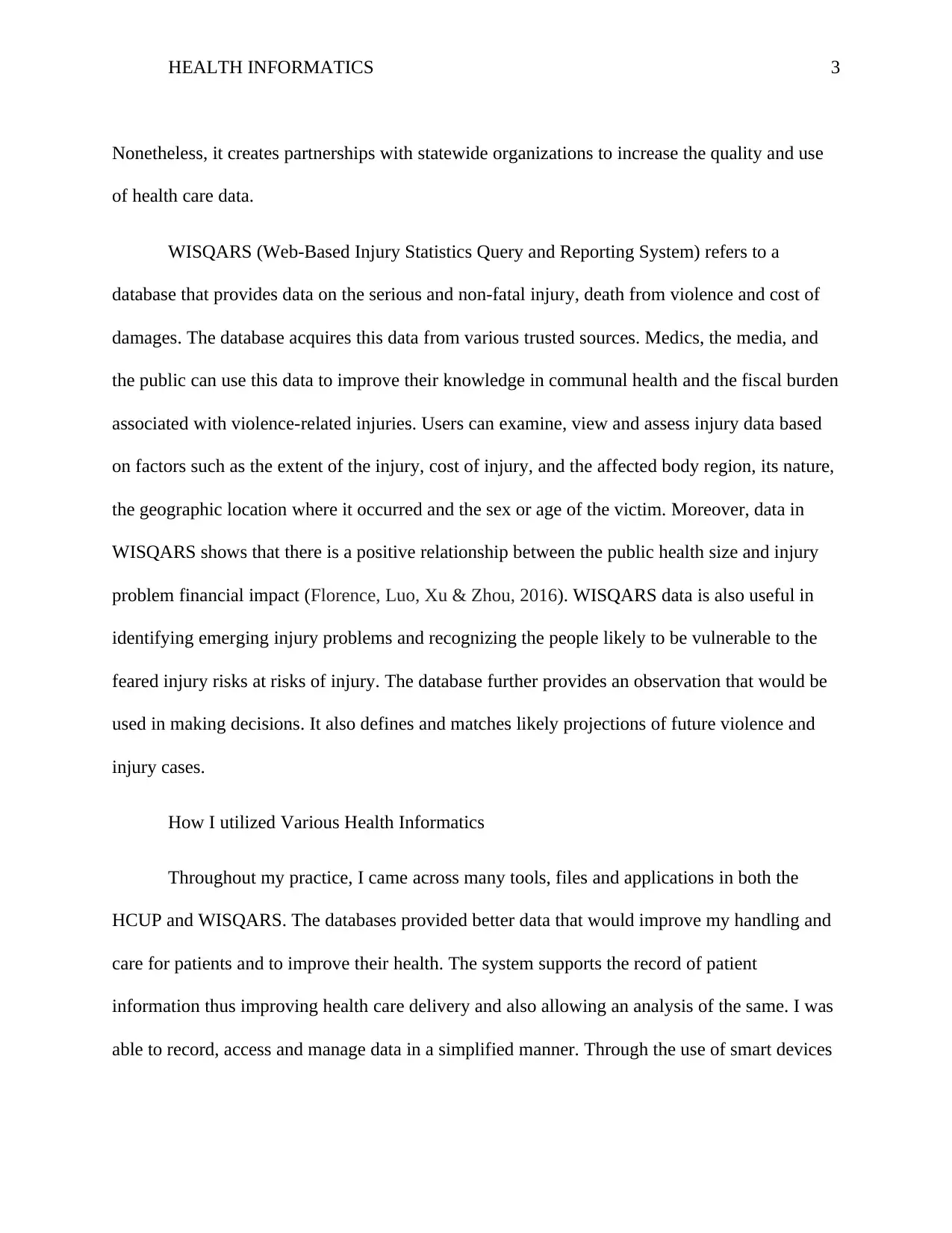
HEALTH INFORMATICS 3
Nonetheless, it creates partnerships with statewide organizations to increase the quality and use
of health care data.
WISQARS (Web-Based Injury Statistics Query and Reporting System) refers to a
database that provides data on the serious and non-fatal injury, death from violence and cost of
damages. The database acquires this data from various trusted sources. Medics, the media, and
the public can use this data to improve their knowledge in communal health and the fiscal burden
associated with violence-related injuries. Users can examine, view and assess injury data based
on factors such as the extent of the injury, cost of injury, and the affected body region, its nature,
the geographic location where it occurred and the sex or age of the victim. Moreover, data in
WISQARS shows that there is a positive relationship between the public health size and injury
problem financial impact (Florence, Luo, Xu & Zhou, 2016). WISQARS data is also useful in
identifying emerging injury problems and recognizing the people likely to be vulnerable to the
feared injury risks at risks of injury. The database further provides an observation that would be
used in making decisions. It also defines and matches likely projections of future violence and
injury cases.
How I utilized Various Health Informatics
Throughout my practice, I came across many tools, files and applications in both the
HCUP and WISQARS. The databases provided better data that would improve my handling and
care for patients and to improve their health. The system supports the record of patient
information thus improving health care delivery and also allowing an analysis of the same. I was
able to record, access and manage data in a simplified manner. Through the use of smart devices
Nonetheless, it creates partnerships with statewide organizations to increase the quality and use
of health care data.
WISQARS (Web-Based Injury Statistics Query and Reporting System) refers to a
database that provides data on the serious and non-fatal injury, death from violence and cost of
damages. The database acquires this data from various trusted sources. Medics, the media, and
the public can use this data to improve their knowledge in communal health and the fiscal burden
associated with violence-related injuries. Users can examine, view and assess injury data based
on factors such as the extent of the injury, cost of injury, and the affected body region, its nature,
the geographic location where it occurred and the sex or age of the victim. Moreover, data in
WISQARS shows that there is a positive relationship between the public health size and injury
problem financial impact (Florence, Luo, Xu & Zhou, 2016). WISQARS data is also useful in
identifying emerging injury problems and recognizing the people likely to be vulnerable to the
feared injury risks at risks of injury. The database further provides an observation that would be
used in making decisions. It also defines and matches likely projections of future violence and
injury cases.
How I utilized Various Health Informatics
Throughout my practice, I came across many tools, files and applications in both the
HCUP and WISQARS. The databases provided better data that would improve my handling and
care for patients and to improve their health. The system supports the record of patient
information thus improving health care delivery and also allowing an analysis of the same. I was
able to record, access and manage data in a simplified manner. Through the use of smart devices
⊘ This is a preview!⊘
Do you want full access?
Subscribe today to unlock all pages.

Trusted by 1+ million students worldwide
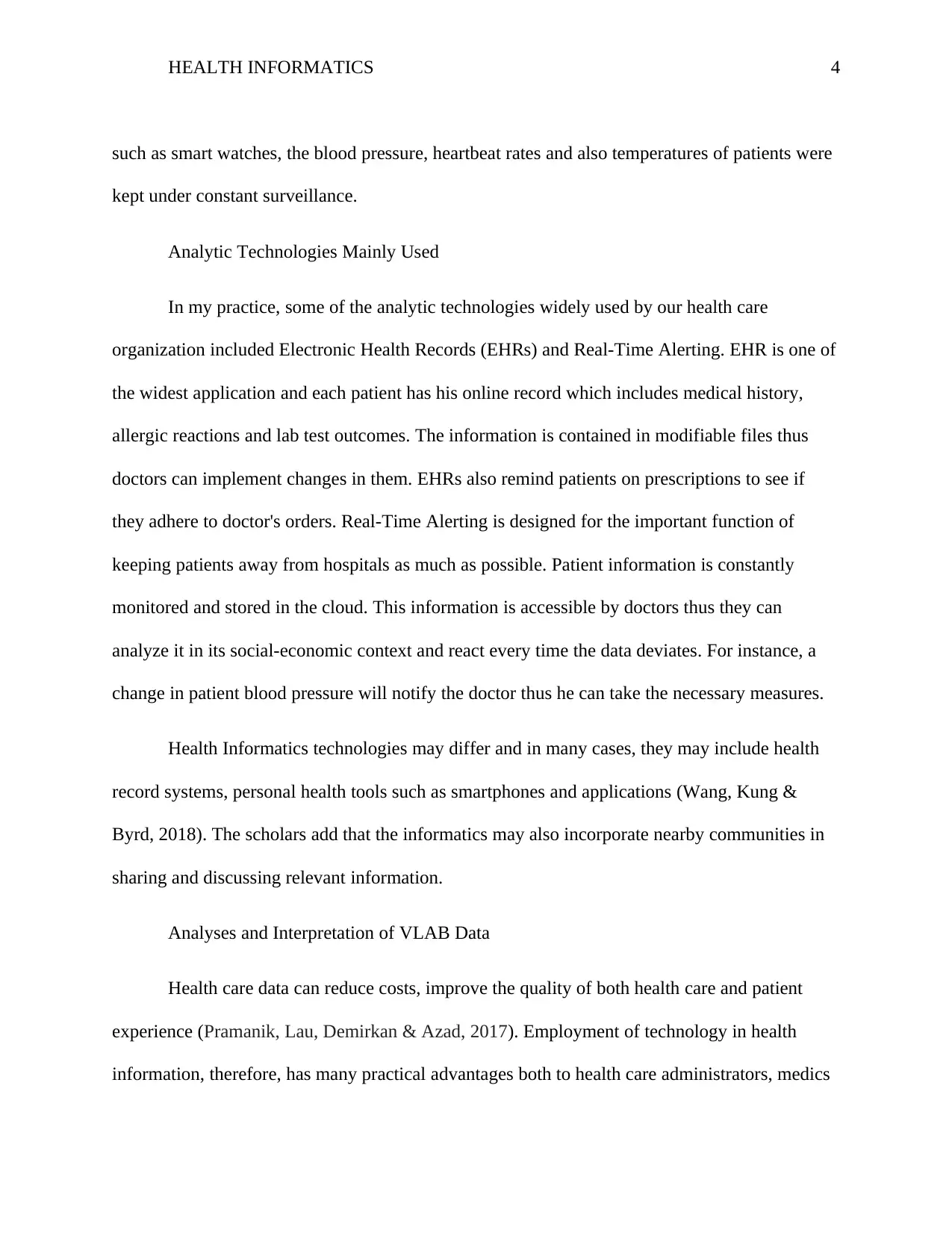
HEALTH INFORMATICS 4
such as smart watches, the blood pressure, heartbeat rates and also temperatures of patients were
kept under constant surveillance.
Analytic Technologies Mainly Used
In my practice, some of the analytic technologies widely used by our health care
organization included Electronic Health Records (EHRs) and Real-Time Alerting. EHR is one of
the widest application and each patient has his online record which includes medical history,
allergic reactions and lab test outcomes. The information is contained in modifiable files thus
doctors can implement changes in them. EHRs also remind patients on prescriptions to see if
they adhere to doctor's orders. Real-Time Alerting is designed for the important function of
keeping patients away from hospitals as much as possible. Patient information is constantly
monitored and stored in the cloud. This information is accessible by doctors thus they can
analyze it in its social-economic context and react every time the data deviates. For instance, a
change in patient blood pressure will notify the doctor thus he can take the necessary measures.
Health Informatics technologies may differ and in many cases, they may include health
record systems, personal health tools such as smartphones and applications (Wang, Kung &
Byrd, 2018). The scholars add that the informatics may also incorporate nearby communities in
sharing and discussing relevant information.
Analyses and Interpretation of VLAB Data
Health care data can reduce costs, improve the quality of both health care and patient
experience (Pramanik, Lau, Demirkan & Azad, 2017). Employment of technology in health
information, therefore, has many practical advantages both to health care administrators, medics
such as smart watches, the blood pressure, heartbeat rates and also temperatures of patients were
kept under constant surveillance.
Analytic Technologies Mainly Used
In my practice, some of the analytic technologies widely used by our health care
organization included Electronic Health Records (EHRs) and Real-Time Alerting. EHR is one of
the widest application and each patient has his online record which includes medical history,
allergic reactions and lab test outcomes. The information is contained in modifiable files thus
doctors can implement changes in them. EHRs also remind patients on prescriptions to see if
they adhere to doctor's orders. Real-Time Alerting is designed for the important function of
keeping patients away from hospitals as much as possible. Patient information is constantly
monitored and stored in the cloud. This information is accessible by doctors thus they can
analyze it in its social-economic context and react every time the data deviates. For instance, a
change in patient blood pressure will notify the doctor thus he can take the necessary measures.
Health Informatics technologies may differ and in many cases, they may include health
record systems, personal health tools such as smartphones and applications (Wang, Kung &
Byrd, 2018). The scholars add that the informatics may also incorporate nearby communities in
sharing and discussing relevant information.
Analyses and Interpretation of VLAB Data
Health care data can reduce costs, improve the quality of both health care and patient
experience (Pramanik, Lau, Demirkan & Azad, 2017). Employment of technology in health
information, therefore, has many practical advantages both to health care administrators, medics
Paraphrase This Document
Need a fresh take? Get an instant paraphrase of this document with our AI Paraphraser
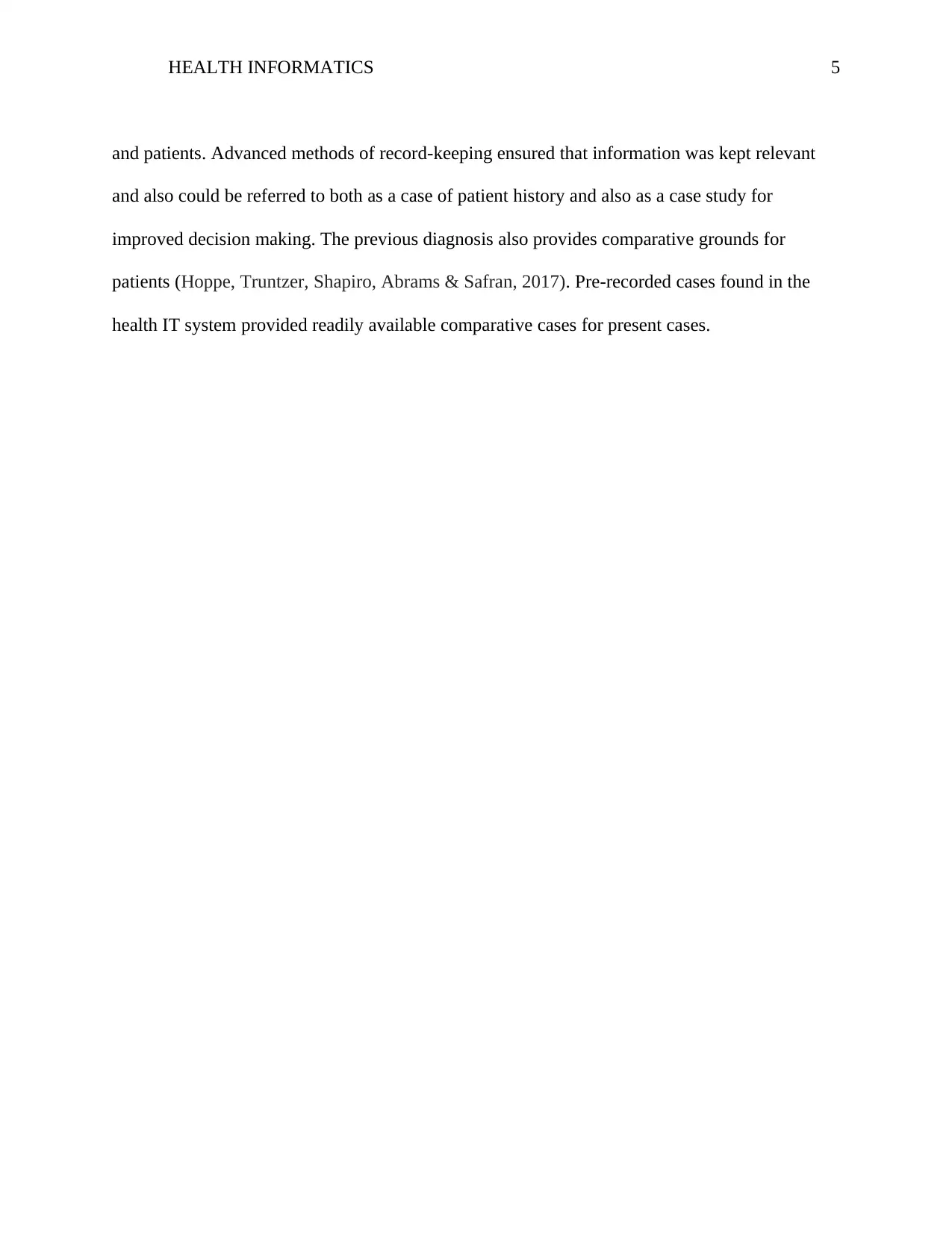
HEALTH INFORMATICS 5
and patients. Advanced methods of record-keeping ensured that information was kept relevant
and also could be referred to both as a case of patient history and also as a case study for
improved decision making. The previous diagnosis also provides comparative grounds for
patients (Hoppe, Truntzer, Shapiro, Abrams & Safran, 2017). Pre-recorded cases found in the
health IT system provided readily available comparative cases for present cases.
and patients. Advanced methods of record-keeping ensured that information was kept relevant
and also could be referred to both as a case of patient history and also as a case study for
improved decision making. The previous diagnosis also provides comparative grounds for
patients (Hoppe, Truntzer, Shapiro, Abrams & Safran, 2017). Pre-recorded cases found in the
health IT system provided readily available comparative cases for present cases.
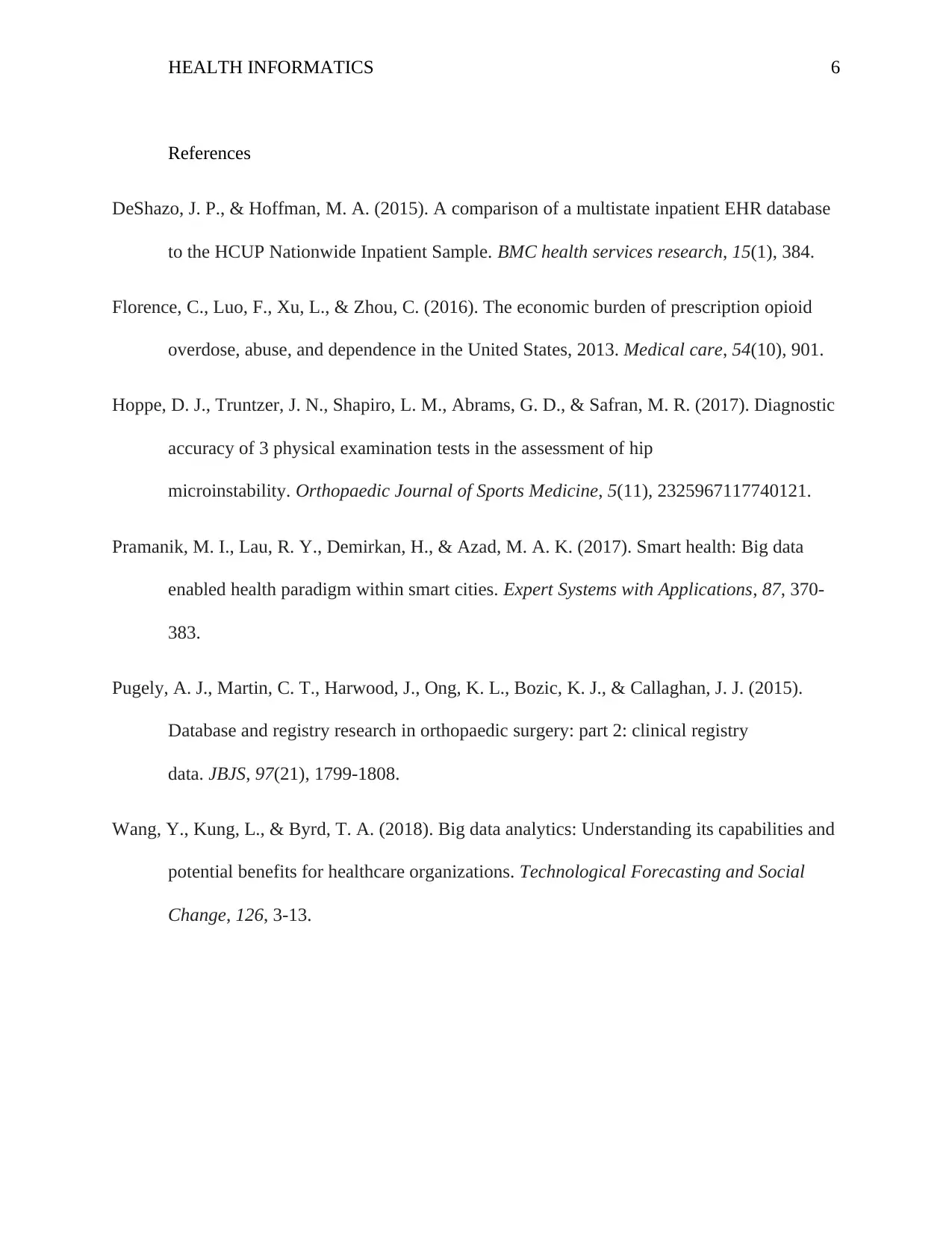
HEALTH INFORMATICS 6
References
DeShazo, J. P., & Hoffman, M. A. (2015). A comparison of a multistate inpatient EHR database
to the HCUP Nationwide Inpatient Sample. BMC health services research, 15(1), 384.
Florence, C., Luo, F., Xu, L., & Zhou, C. (2016). The economic burden of prescription opioid
overdose, abuse, and dependence in the United States, 2013. Medical care, 54(10), 901.
Hoppe, D. J., Truntzer, J. N., Shapiro, L. M., Abrams, G. D., & Safran, M. R. (2017). Diagnostic
accuracy of 3 physical examination tests in the assessment of hip
microinstability. Orthopaedic Journal of Sports Medicine, 5(11), 2325967117740121.
Pramanik, M. I., Lau, R. Y., Demirkan, H., & Azad, M. A. K. (2017). Smart health: Big data
enabled health paradigm within smart cities. Expert Systems with Applications, 87, 370-
383.
Pugely, A. J., Martin, C. T., Harwood, J., Ong, K. L., Bozic, K. J., & Callaghan, J. J. (2015).
Database and registry research in orthopaedic surgery: part 2: clinical registry
data. JBJS, 97(21), 1799-1808.
Wang, Y., Kung, L., & Byrd, T. A. (2018). Big data analytics: Understanding its capabilities and
potential benefits for healthcare organizations. Technological Forecasting and Social
Change, 126, 3-13.
References
DeShazo, J. P., & Hoffman, M. A. (2015). A comparison of a multistate inpatient EHR database
to the HCUP Nationwide Inpatient Sample. BMC health services research, 15(1), 384.
Florence, C., Luo, F., Xu, L., & Zhou, C. (2016). The economic burden of prescription opioid
overdose, abuse, and dependence in the United States, 2013. Medical care, 54(10), 901.
Hoppe, D. J., Truntzer, J. N., Shapiro, L. M., Abrams, G. D., & Safran, M. R. (2017). Diagnostic
accuracy of 3 physical examination tests in the assessment of hip
microinstability. Orthopaedic Journal of Sports Medicine, 5(11), 2325967117740121.
Pramanik, M. I., Lau, R. Y., Demirkan, H., & Azad, M. A. K. (2017). Smart health: Big data
enabled health paradigm within smart cities. Expert Systems with Applications, 87, 370-
383.
Pugely, A. J., Martin, C. T., Harwood, J., Ong, K. L., Bozic, K. J., & Callaghan, J. J. (2015).
Database and registry research in orthopaedic surgery: part 2: clinical registry
data. JBJS, 97(21), 1799-1808.
Wang, Y., Kung, L., & Byrd, T. A. (2018). Big data analytics: Understanding its capabilities and
potential benefits for healthcare organizations. Technological Forecasting and Social
Change, 126, 3-13.
⊘ This is a preview!⊘
Do you want full access?
Subscribe today to unlock all pages.

Trusted by 1+ million students worldwide
1 out of 6
Related Documents
Your All-in-One AI-Powered Toolkit for Academic Success.
+13062052269
info@desklib.com
Available 24*7 on WhatsApp / Email
![[object Object]](/_next/static/media/star-bottom.7253800d.svg)
Unlock your academic potential
Copyright © 2020–2025 A2Z Services. All Rights Reserved. Developed and managed by ZUCOL.





